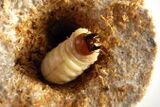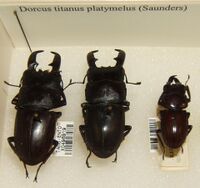Biology:Giant stag beetle
| Giant stag beetle | |
|---|---|

| |
| Dorcus titanus (above) | |
| Scientific classification | |
| Kingdom: | Animalia
|
| Phylum: | |
| Class: | |
| Order: | |
| Family: | |
| Genus: | |
| Species: | D. titanus
|
| Binomial name | |
| Dorcus titanus (Boisduval, 1835)
| |
| Synonyms[1] | |
| |
The giant stag beetle (Dorcus titanus) is a beetle of the family Lucanidae. It was described by Jean Baptiste Boisduval in 1835. In the research of Huang and Chen (2013), Serognathus has separated from Dorcus, showing the morphological and DNA analysis.
Description
Males measure 32.0–111.3 millimetres (1.26–4.38 in) including mandibles; females 36.5–54 millimetres (1.44–2.13 in). It has an elongated, somewhat flat body dull black with blackish antennae and legs. Male's antler-like jaws have small teeth along inner edge and a pair of big teeth toward the bottom, and are forked at end. The head of a large male reaches nearly the length of its prothorax and abdomen combined.[2]
Life cycle
Adults can be seen from May to August. They feed on tree juice, especially of Quercus species. Females lay eggs on the underground part of fallen oaks. The eggs hatch in about a month and the larvae feed on rotten wood. The larval period lasts about one year. The complete life cycle can last approximately from 1 to 2 years.[2]
Distribution
This species is present in Japan, Indonesia, the Philippines, Malaysia, Thailand, Vietnam, Laos, Myanmar, India, China, Taiwan and Korea.[1][3]
Habitat
It mainly inhabits tropical rainforests and temperate forests from lowland to mountains.[2]
Popular culture
This beetle has some commercial value and export from some regions is criminalized. There are some Asian cultures that assign aphrodisiac properties to this insect, high in protein. However, most are imported for sport, decorative show, or to be kept as an exotic pet. This stag beetle is also popular pet in Asia and Europe.
Gallery
List of subspecies
- Dorcus titanus castanicolor - Tsushima, Korean Peninsula (넓적사슴벌레/(in Korean)), Mainland China
- Dorcus titanus daitoensis
- Dorcus titanus elegans
- ’’Dorcus titanus fafner’’ (Vietnam Stag Beetle)
- Dorcus titanus hachijoensis
- ’’Dorcus titanus imperialis‘’ (Philippine Stag Beetle)
- ’’Dorcus titanus isabella’’ (Isabella Stag Beetle)
- Dorcus titanus karasuyamai
- ’’Dorcus titanus mindanaoensis‘’ (Mindanao Stag Beetle)
- ’’Dorcus titanus nobuyukii‘’ (Malaysia Stag Beetle)
- Dorcus titanus okinawanus - Okinawa
- Dorcus titanus okinoerabuensis
- Dorcus titanus palawanicus - Palawan Island (Palawan Stag Beetle)
- Dorcus titanus pilifer - Japan
- Dorcus titanus platymelus - China (Chinese Stag Beetle)
- Dorcus titanus sakishimanus - Japan (サキシマヒラクワガタ/(in Japanese))
- Dorcus titanus sika (台灣扁鍬形蟲/(in Chinese)) (Taiwan Stag Beetle)
- Dorcus titanus titanus'’
- Dorcus titanus takaraensis
- Dorcus titanus tatsutai
- Dorcus titanus tokunoshimaensis
- Dorcus titanus typhon - Philippines . (Sulawesi giant stag beetle)
- Dorcus titanus typhoniformis (Unnan Stag Beetle)
- Dorcus titanus westermanni (Indian Stag Beetle)
- ’’Dorcus titanus yasuokai‘’ (Sumatra Stag Beetle)
References
- Mizunuma T. & Nagai S. (1994) The Lucanid Beetles of the World. Mushi-Sha's Iconographic Series of Insects, Ed. H. Fujita, Japan. Vol. I
- Huang, H. & Chen, C.-C. 2013: Stag beetles of China Ⅱ
External links
Wikidata ☰ Q874874 entry






